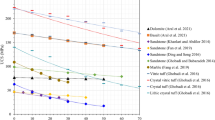Abstract
In this paper, the mechanical properties and strain softening model of rock in cold regions after the peak were investigated. Freeze–thaw cycle tests and triaxial compression tests were performed on green sandstone to obtain stress–strain curves for rocks under different freeze–thaw cycles. The deformation, strength, and post-peak characteristics of rocks under freeze–thaw cycles and triaxial compression were analyzed, including brittleness and drop degree. On this basis, the experimental data were used to draw the Mohr stress circle and its corresponding envelope under different freeze–thaw cycles and confining pressure conditions. It also determines the generalized cohesion \(\bar{c }\) and the generalized internal friction angle \(\bar{\varphi }\) under different freeze–thaw cycles and confining pressure conditions. Least square surface fitting was used to obtain the softening law of post-peak strength parameters of frozen–thawed rock. Finally, a constitutive model was established that accurately reflects the post-peak strain softening behavior of rock under freeze–thaw cycles. The model uses the maximum principal strain \({\varepsilon }_{1}\) as the softening parameter and subjects the strength parameters (generalized cohesion \(\bar{c }\), generalized internal friction angle \(\bar{\varphi }\)) to piecewise linear evolution according to the Mohr–Coulomb criterion. The paper concludes by comparing and analyzing the influence of each strength parameter on the post-peak strain softening behavior of rock.











Similar content being viewed by others
Data availability
The data used to support the findings of this study are available from the corresponding author upon request.
References
Cao ZQ, Zhang Z, Tian XB (2007) Rock density structure in Bangong–Nujiang suture zone and its significance. Chin J Geophys Chin Ed 50(2):523–528
Cao R, Wang C, Hu T, Yao R, Li T, Lin Q (2022) Experimental investigation of plane shear fracture characteristics of sandstone after cyclic freeze–thaw treatments. Theor Appl Fract Mech. https://doi.org/10.1016/j.tafmec.2021.103214
Chen YL, Ni J, Jiang LH, Liu ML, Wang P, Azzam R (2014) Experimental study on mechanical properties of granite after freeze–thaw cycling. Environ Earth Sci 71(8):3349–3354. https://doi.org/10.1007/s12665-013-2725-0
Chen JC, Wang WH, Chen LF (2023) A strain hardening and softening constitutive model for hard brittle rocks. Appl Sci Basel 13:5. https://doi.org/10.3390/app13052764
Fang XY, Xu JY, Wang PX (2018) Compressive failure characteristics of yellow sandstone subjected to the coupling effects of chemical corrosion and repeated freezing and thawing. Eng Geol 233:160–171. https://doi.org/10.1016/j.enggeo.2017.12.014
Fener M, İnce İ (2015) Effects of the freeze–thaw (F–T) cycle on the andesitic rocks (Sille-Konya/Turkey) used in construction building. J Afr Earth Sc 109:96–106. https://doi.org/10.1016/j.jafrearsci.2015.05.006
Feng Q, Jin J, Zhang S, Liu W, Yang X, Li W (2022) Study on a damage model and uniaxial compression simulation method of frozen–thawed rock. Rock Mech Rock Eng 55(1):187–211. https://doi.org/10.1007/s00603-021-02645-2
Fu HL, Zhang JB, Huang Z, Shi Y, Chen W (2018) A statistical model for predicting the triaxial compressive strength of transversely isotropic rocks subjected to freeze–thaw cycling. Cold Reg Sci Technol 145:237–248. https://doi.org/10.1016/j.coldregions.2017.11.003
Gao F, Xiong X, Zhou KP, Li JL, Shi WC (2019) Strength deterioration model of saturated sandstone under freeze–thaw cycles. Rock Soil Mech 40(3):926–932. https://doi.org/10.16285/j.rsm.2017.1886
Gao F, Xiong X, Xu CS, Zhou KP (2021) Mechanical property deterioration characteristics and a new constitutive model for rocks subjected to freeze–thaw weathering process. Int J Rock Mech Min Sci. https://doi.org/10.1016/j.ijrmms.2021.104642
Goudie AS (1999) Experimental salt weathering of limestones in relation to rock properties. Earth Surf Processes Landforms 24(8):715–724
Gullu H, Khudir A (2014) Effect of freeze–thaw cycles on unconfined compressive strength of fine-grained soil treated with jute fiber, steel fiber and lime. Cold Reg Sci Technol 106:55–65. https://doi.org/10.1016/j.coldregions.2014.06.008
Han JX, Li SC, Li SC, Yang WM, Wang L (2013) Study of post-peak stress–strain relationship of rock material based on evolution of strength parameters. Rock Soil Mech 34(02):342–346. https://doi.org/10.16285/j.rsm.2013.02.013
He MM, Zhang ZQ, Zhu JW, Li N (2022) Correlation between the constant m(i) of Hoek–Brown criterion and porosity of intact rock. Rock Mech Rock Eng 55(2):923–936. https://doi.org/10.1007/s00603-021-02718-2
Hou PY, Cai M (2022) Post-peak stress-strain curves of brittle hard rocks under different loading environment system stiffness. Rock Mech Rock Eng 55(7):3837–3857. https://doi.org/10.1007/s00603-022-02839-2
Lan YW, Gao HM, Zhao YL (2022) Pore structure characteristics and strength variation of red sandstone under freeze-thaw cycles. Materials. https://doi.org/10.3390/ma15113856
Lei D, Lin H, Chen Y, Cao R, Wen Z (2019) Effect of cyclic freezing-thawing on the shear mechanical characteristics of nonpersistent joints. Adv Mater Sci Eng. https://doi.org/10.1155/2019/9867681
Lei D, Lin H, Wang Y (2022) Damage characteristics of shear strength of joints under freeze–thaw cycles. Arch Appl Mech 92(5):1615–1631. https://doi.org/10.1007/s00419-022-02136-y
Li G, Ma FS, Liu G, Zhao HJ, Guo J (2019a) A strain-softening constitutive model of heterogeneous rock mass considering statistical damage and its application in numerical modeling of deep roadways. Sustainability. https://doi.org/10.3390/su11082399
Li J, Kaunda RB, Zhu L, Zhou K, Gao F (2019b) Experimental study of the pore structure deterioration of sandstones under freeze–thaw cycles and chemical erosion. Adv Civil Eng. https://doi.org/10.1155/2019/9687843
Li J, Zhu L, Zhou K, Chen H, Gao L, Lin YS (2021) Non-linear creep damage model of sandstone under freeze–thaw cycle. J Central South Univ 28(3):954–967. https://doi.org/10.1007/s11771-021-4656-3
Liu QS, Huang SB, Kang YS, Liu XW (2015) A prediction model for uniaxial compressive strength of deteriorated rocks due to freeze-thaw. Cold Reg Sci Technol. 120:96–107. https://doi.org/10.1016/j.coldregions.2015.09.013
Liu C, Deng H, Zhao H, Zhang J (2018) Effects of freeze–thaw treatment on the dynamic tensile strength of granite using the Brazilian test. Cold Reg Sci Technol 155:327–332. https://doi.org/10.1016/j.coldregions.2018.08.022
Liu C, Wang D, Wang Z, Ke B, Li P, Yu S (2021a) Dynamic splitting tensile test of granite under freeze–thaw weathering. Soil Dyn Earthq Eng. https://doi.org/10.1016/j.soildyn.2020.106411
Liu Q, Chen W, Guo JK, Li RF, Ke D, Wu Y, Tian W, Li XZ (2021b) Fractional stress relaxation model of rock freeze–thaw damage. Adv Mater Sci Eng. https://doi.org/10.1155/2021/3936968
Lu YL, Wang LG, Yang F, Li YJ, Chen HM (2010) Post-peak strain softening mechanical properties of weak rock. Chin J Rock Mech Eng 29(03):640–648
Luo Y, Qu D, Wang G, Li X, Zhang G (2020) Degradation model of the dynamic mechanical properties and damage failure law of sandstone under freeze–thaw action. Soil Dyn Earthq Eng. https://doi.org/10.1016/j.soildyn.2020.106094
Ocak I (2008) Estimating the modulus of elasticity of the rock material from compressive strength and unit weight. J South Afr Inst Min Metall 108(10):621–626
Peng J, Cai M, Rong G, Yao MD, Jiang QH, Zhou CB (2017) Determination of confinement and plastic strain dependent post-peak strength of intact rocks. Eng Geol 218:187–196. https://doi.org/10.1016/j.enggeo.2017.01.018
Ren J, Yun M, Cao X, Zhang K, Liang Y, Chen X (2022) Study on the mechanical properties of saturated red sandstone under freeze–thaw conditions. Environ Earth Sci. https://doi.org/10.1007/s12665-022-10503-9
Tan XJ, Chen WZ, Yang JP, Cao JJ (2011) Laboratory investigations on the mechanical properties degradation of granite under freeze–thaw cycles. Cold Reg Sci Technol 68(3):130–138. https://doi.org/10.1016/j.coldregions.2011.05.007
Tan X, Konietzky H, Frühwirt T (2015) Numerical simulation of triaxial compression test for brittle rock sample using a modified constitutive law considering degradation and dilation behavior. J Central South Univ 22(8):3097–3107
Wang L, Li N, Qi J, Tian Y, Xu S (2019) A study on the physical index change and triaxial compression test of intact hard rock subjected to freeze–thaw cycles. Cold Reg Sci Technol 160:39–47. https://doi.org/10.1016/j.coldregions.2019.01.001
Zhang J, Deng H, Taheri A, Ke B, Liu C, Yang X (2018) Degradation of physical and mechanical properties of sandstone subjected to freeze–thaw cycles and chemical erosion. Cold Reg Sci Technol 155:37–46. https://doi.org/10.1016/j.coldregions.2018.07.007
Zhang HM, Meng XZ, Yang GS (2020a) A study on mechanical properties and damage model of rock subjected to freeze-thaw cycles and confining pressure. Cold Reg Sci Technol 174: 103056. https://doi.org/10.1016/j.coldregions.2020.103056
Zhang JJ, Yin YY, Zhang GZ (2020b) Rock physics modelling of porous rocks with multiple pore types: a multiple-porosity variable critical porosity model. Geophys Prospect 68(3):955–967. https://doi.org/10.1111/1365-2478.12898
Zhao XF, Lv XJ, Wang L, Zhu YF, Dong H, Chen W, Li JK, Ji B, Ding YB (2015) Research of concrete residual strains monitoring based on WLI and FBG following exposure to freeze–thaw tests. Cold Reg Sci Technol 116:40–48. https://doi.org/10.1016/j.coldregions.2015.04.007
Zhou HW, Xie H (2004) Anisotropic characterization of rock fracture surfaces subjected to profile analysis. Phys Lett A 325(5–6):355–362. https://doi.org/10.1016/j.physleta.2004.04.006
Zhou ZW, Ma W, Zhang SJ, Mu YH, Li GY (2018) Effect of freeze–thaw cycles in mechanical behaviors of frozen loess. Cold Reg Sci Technol 146:9–18. https://doi.org/10.1016/j.coldregions.2017.11.011
Acknowledgements
This work was supported by Hunan Provincial Natural Science Foundation of China (Grant No. 2020JJ4704) and the Fundamental Research Funds for the Central Universities of Central South University (Grant No. 2021zzts0279).
Author information
Authors and Affiliations
Contributions
Feng Gao: Conceptualization, Supervision, Formal analysis and Writing - Original Draft Jinxi Xie: Methodology, Investigation and Data Curation Xin Xiong: Data Curation, Investigation and Writing - Review & Editing Keping Zhou: Conceptualization and Supervision.
Corresponding author
Ethics declarations
Conflict of Interest
The authors declare that they have no conflict of interest.
Additional information
Publisher's Note
Springer Nature remains neutral with regard to jurisdictional claims in published maps and institutional affiliations.
Rights and permissions
Springer Nature or its licensor (e.g. a society or other partner) holds exclusive rights to this article under a publishing agreement with the author(s) or other rightsholder(s); author self-archiving of the accepted manuscript version of this article is solely governed by the terms of such publishing agreement and applicable law.
About this article
Cite this article
Gao, F., Xie, J., Xiong, X. et al. Post-peak mechanical property and a new strain softening model for rocks subjected to freeze–thaw cycles. Environ Earth Sci 82, 531 (2023). https://doi.org/10.1007/s12665-023-11223-4
Received:
Accepted:
Published:
DOI: https://doi.org/10.1007/s12665-023-11223-4




